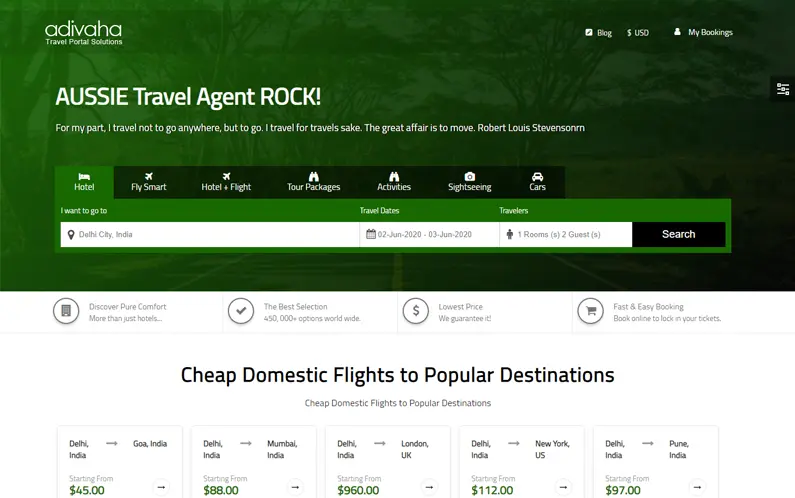Ready to go-LIVE travel solutions that helps your travel agency to sell a range of travel services pretty instantly. adivaha® travel solutions make sure you have no boundation over your imagination, you can do everything online, without the need for any technical knowledge or design skills. Easy Backoffice, extensive reporting with integrated Funds Management System.
Integrate Expedia Hotel API for Enhanced Bookings
Expedia Hotel API Integration is a vital feature for businesses looking to expand their reach in the hospitality industry. By leveraging the Expedia Hotel API, hoteliers can seamlessly connect their booking systems with Expedia's vast database of accommodation options. This integration enables real-time availability updates, booking confirmations, and streamlined management of room inventory. The ease of use and extensive resources provided by Expedia's API make it a popular choice among hotel operators seeking to optimize their online presence and attract a larger customer base. When implemented effectively, Expedia Hotel API Integration can result in increased bookings and revenue for hotel businesses.
When it comes to hotel API integrations, Google Hotel API is another powerful tool that hoteliers can utilize to enhance their online visibility and streamline the booking process. With Google Hotel API Example, hotel businesses can showcase their property information, room rates, and availability directly on Google's platform, making it easier for potential guests to discover and book their accommodations. The Google Hotel Search API offers robust search functionality, allowing users to filter results based on specific criteria such as price range, location, and amenities. By incorporating Google Hotel API into their websites or booking systems, hotel operators can improve their online visibility and attract more direct bookings from travelers using Google's search engine.
In conclusion, integrating Expedia Hotel API and Google Hotel API into a hotel's online booking system can significantly boost its visibility, bookings, and revenue potential. By tapping into Expedia's extensive network and Google's powerful search capabilities, hoteliers can reach a broader audience of potential guests and provide a seamless booking experience. Expedia Hotel API Integration streamlines inventory management and booking processes, while Google Hotel API enhances a hotel's online presence and accessibility to travelers searching for accommodations. Overall, leveraging these APIs can drive growth and success for hotel businesses looking to thrive in the competitive hospitality industry.
Hotel API booking engines play a vital role in the seamless functioning of online hotel booking platforms. These engines are powered by hotel API providers, which offer a direct connection to a wide range of hotel inventories. Utilizing a hotel API booking engine enables travel agencies, tour operators, and online travel agents to access real-time data on hotel availability, rates, and amenities across multiple properties. The integration of a hotel API provider ensures that users can search, book, and manage their hotel reservations efficiently through a unified platform.
Hotels APIs are integral components of the modern travel industry, facilitating instant access to a vast network of accommodation options for travelers worldwide. By leveraging hotel APIs, developers can build robust booking engines that offer users a comprehensive selection of hotels to choose from based on their preferences and budget. The seamless integration of hotel APIs enables users to compare prices, read reviews, and confirm bookings in a convenient and user-friendly manner. Hotel API booking engines have revolutionized the way people plan and book their travel accommodations, offering a convenient and reliable solution for both travelers and businesses alike.
In the competitive landscape of online travel services, the reliance on hotel API booking engines has become increasingly essential for businesses looking to provide a streamlined booking experience. Hotel APIs are instrumental in aggregating hotel inventory from various sources, allowing users to access up-to-date information on room availability and pricing. By incorporating a hotel API provider into their systems, online travel platforms can ensure that users have access to a diverse selection of accommodations, enhancing their overall booking experience. The integration of hotel APIs empowers businesses to offer a comprehensive and efficient booking process, driving customer satisfaction and loyalty in the ever-evolving travel industry.
Integrate Expedia Hotel API for Enhanced Bookings
When it comes to optimizing your hotel booking process, leveraging a powerful tool like a hotel API booking engine is essential. By integrating the right hotel API provider such as Expedia, hotels can streamline their booking procedures and provide customers with a seamless experience. Expedia's robust hotel APIs offer a wide range of features and functionalities that can enhance the overall booking experience for both hoteliers and guests.
Incorporating a hotel API booking engine like Expedia's can significantly improve the efficiency and accuracy of the booking process. With real-time data synchronization, hoteliers can ensure that room availability and rates are always up to date, minimizing the risk of overbooking or discrepancies. By tapping into Expedia's extensive network of hotel partners and inventory, hoteliers can offer guests a wider selection of accommodations to choose from, leading to increased booking conversions and revenue.
By harnessing the power of hotel APIs, such as Expedia's innovative solutions, hoteliers can stay ahead in today's competitive hospitality industry. These APIs allow for seamless integration with existing booking systems, making it easy for hotels to enhance their online presence and attract more guests. With Expedia's hotel API booking engine, hotels can take their booking capabilities to the next level, offering a user-friendly interface that simplifies the reservation process and boosts customer satisfaction.
Keep Refreshing your customers - Who doesn't want his site to stand out from crowd? adivaha® gives you multiple options for home pages, headers, colors etc. Which can easily be managed from admin via shortcodes and settings. The theme supports almost all the big players in this market ie, WEGO, Travelpayouts, Agoda, Booking, Expedia etc.












